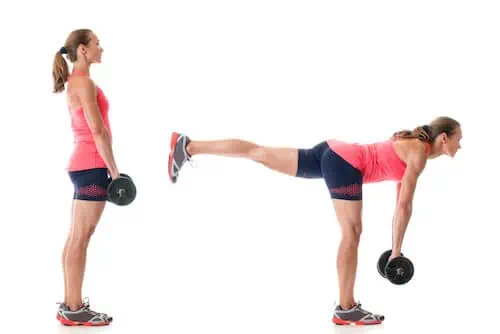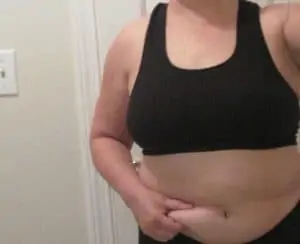I’ve written about diastasis recti before, and while I encourage you to check that out, I’d also like to give you some tips on how to do diastasis recti exercises after your c-section.
For those who don’t know, this condition creates a bulge between the right and left side of the stomach muscles, giving you a protruding belly. It can happen to mamas that have c-sections or vaginal births.
In fact, you’re more at risk if you’ve had more than one pregnancy, any of your babies were large at birth, or you had multiples. Additionally, you have an even greater risk if you’re over 35 or have had your pregnancies back to back.
Check to See If You Have Diastasis Recti
Diastasis recti is easy to spot. If you look in the mirror, you may see a dome-shaped bulge near your belly button. You may also notice a gap that’s about two fingers in width apart.
You can ask your doctor at your next checkup, or you can check yourself by simply lying on your back. Bend your knees upward as though you were going to do crunches (but please DO NOT do crunches, for they can make diastasis recti worse).
While lying in this position, put your fingers above your belly button. Then gently raise your head and shoulders slowly off the floor. If you feel a gap with your fingers or see the bulging, you likely have diastasis recti.
Don’t be sad, though, for these diastasis recti exercises after c-section can help restore everything.
Exercises That Help Your Recovery from Diastasis Recti
I will give you a few exercises you can do daily to help you repair this area. Please make sure with your doctor first, as I don’t know your condition personally.
Abdominal Breathing
Abdominal breathing will be the foundation you use to get your body back through these exercises. You want to lie on your back, keeping your knees bent while the arch of your back is pressed into the ground. Put your hand on your belly and take a nice, deep breath. As you breathe, you want to expand your abdominal muscles so they push your hand up and away.
While exhaling, contract those abdominal muscles to pull your belly button towards the spine. You can keep doing this throughout the day to help build preliminary strength in this area.
Heel Drop
The heel drop will help you heal, and it’s easy too. You’ll start lying on your back with your knees lifted over your hips. Please don’t bring them close to your chest; keep your hands at your sides. Once in this position, slowly drop one foot down to the floor, tapping your toes.
You’ll lift that leg back up again while bringing the other one down for the toe tap. Quickly exhale during this exercise while keeping your back flat on the mat the entire time.
Heel Slide
Next up, you’ll stay in the same position while you take your fingertips and put them just to the inside of your pelvic bones. Keep a neutral spine, then activate the muscles underneath those fingertips.
You should keep your pelvis in this exact position as you shift one leg straight, return it to starting position, and then repeat on the other side. Doing this 10 times is an ideal set.
Leg Deadlift

Stand up now and keep one knee slightly bent. You’ll bend at the hip while extending your free leg behind you to help you stay balanced. You can do this with or without weights (start without), lowering until you are parallel to the ground. You’ll return to an upright position and continue with the other leg.
Side Plank
Unlike a regular plank, the side plank is a safe one to perform if you have diastasis recti. You’ll lie on your side on a mat, moving your forearm under your shoulder so it is perpendicular to your body. Put your upper leg so it is directly on top of your lower leg, straightening your knees and hips. Now, raise your entire body upward as you straighten your waist and hold. Repeat on the other side when you’re done.
Pelvic Tilts
On your back, bend your knees and curl your hips toward your ribcage. Engage your abs as you do and press your lower back into the ground. Lower your pelvis back to the ground and repeat for a set of 10.
Wall Sits
Wall sits are great exercise for everyone. They build up core strength without strain. Simply stand against a wall and slide into a squat as though you are sitting on a chair right against that wall. Try to hold it for as long as you can each time.
Exercises You Should Never Do with Diastasis Recti
It will likely take you a little practice to get these moves right. And that’s fine! Slow and steady will win the race.
But please, do not make any moves that will cause your abs to bulge out from your body. You need to heal this area first before returning to a normal routine.
What can’t you do until you heal from diastasis recti?
NEVER do crunches, planks (except the side plank), sit-ups, twists (for obliques or even those Russian twists), and pushups.
Suppose you’d like support while you heal this area and build strength. In that case, I recommend finding a personal trainer in your area who is experienced with core dynamics and healing diastasis recti. It’s definitely worth it!
Leslie Berry lives with her husband and two young daughters in Los Altos, California, where she loves helping other moms get comfortable with motherhood and embracing the insanity with facts peppered with laughs.
She loves eating too much sushi, exercising, and jamming out on her Fender. Read more about Leslie here.






